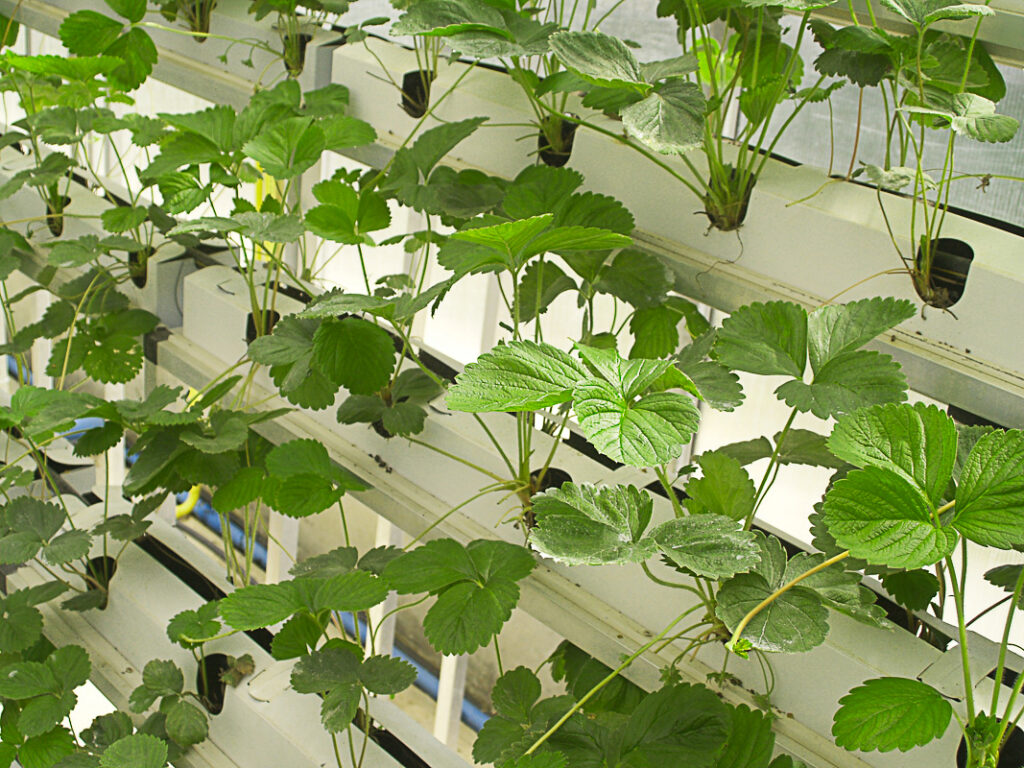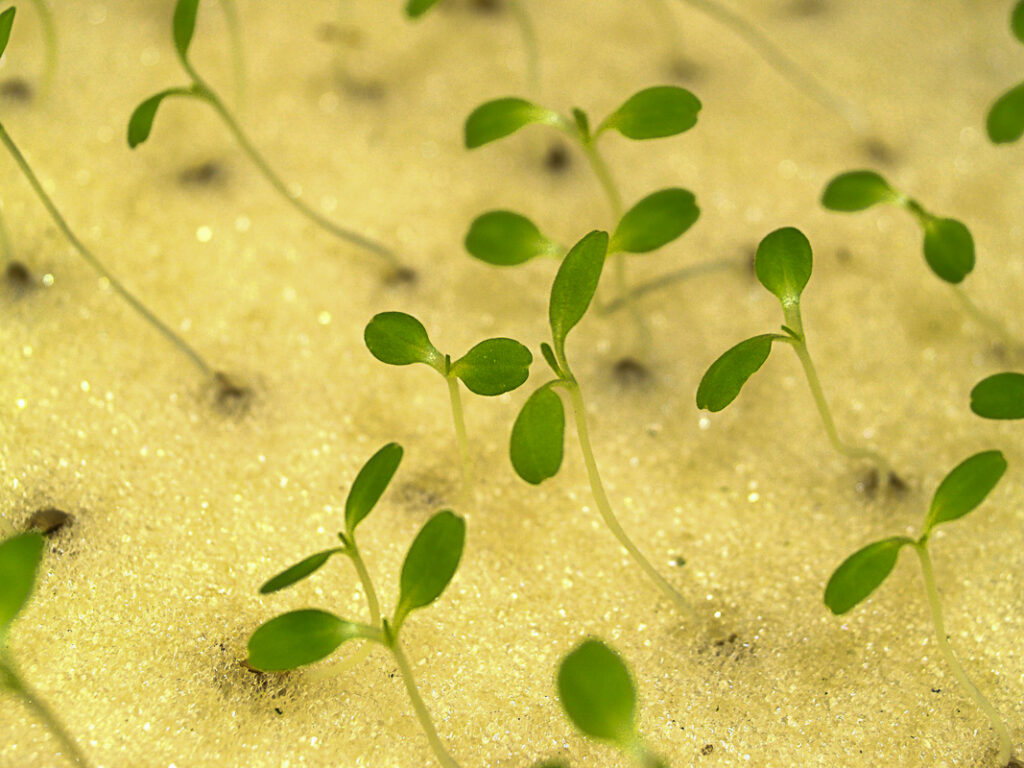Hydroponic microgreens use a technique for growing plants without soil. The microgreens will grow in water mixed with a nutrient solution. The plants will absorb all the nutrients and oxygen they need from the water. Growing hydroponic microgreens at home is a great way to have fresh microgreens ready for any salad or recipe.
*This post contains compensated links. Find more info in my DISCLAIMER. As an Amazon Associate, I earn from qualifying purchases.
Want to start a hydroponic garden at home easily? Check out our recommendations for Best Hydroponics Starter Kits for Beginners.
What Are Hydroponic Microgreens
Hydroponics allows you to grow microgreens without dealing with soil. The plants live in an aquatic environment where they receive their oxygen and nutrients from the water rather than absorbing them from the soil.
Growing these miniature versions of vegetables and herbs at home without soil seems futuristic and high-tech. However, it s much easier than you think.
You can begin by finding a suitable hydroponic microgreens kit, which makes your work easier because it comes with all the necessary supplies. The kit will contain a variety of microgreen seeds, a growing medium, planters and growing trays, and an instruction booklet. It is the most convenient way to start growing microgreens at home.
Is It Better To Grow Microgreens In Water Or Soil
Microgreens are easy to grow, yield incredibly fast, and taste great. They are also a favorite for home gardeners, serious commercial farmers, chefs, hobbyists, and foodies. But which is the best way to grow microgreens?
Growing microgreens in the soil is the most common method. Soil contains natural nutrients, retains water well, and is easy to work with. Numerous companies make seed-starting soils suitable for growing microgreens.
However, growing microgreens in soil has its downsides. Dealing with soil is messy and a hassle to clean up. In addition, you should wash away the contamination and grit left behind by the soil. But washing microgreens makes them vulnerable to mold and reduces their shelf life.
Hydroponics is the solution because it allows you to grow microgreens without soil. When you grow microgreens hydroponically, you eliminate all the downsides of having to deal with soil. However, there is also a challenge; a hydroponic microgreens system is more difficult to optimize compared to soil.
Advantages Of Growing Microgreens In Water
Growing microgreens hydroponically has numerous benefits, including:
Use Less Water
You can re-use the water in a hydroponic microgreens system. This enables you to use about 20 times less water than in a traditional soil-based system.
You Can Grow Your Favorite Microgrees Anywhere
A hydroponics setup is ideal for a wide range of environments compared to a soil-based system that is best managed outdoors. It gives you more flexibility and allows you to grow microgreens all year round. You can set up a hydroponic microgreens system in your garage, rooftop, basement, or inside a shipping container.
More Control
You have the ultimate control of what type and how much nutrients your microgreens get. If you grow microgreens hydroponically indoors, you also have control over environmental factors like water pH, temperature, and lighting.
No Soil-Borne Diseases
Most diseases that attack crops are soil-borne. You eliminate all these threats when you grow microgreens without soil.
Better Yield
You can stack your hydroponic microgreens vertical to take advantage of the square footage upwards. In addition, you can grow the plants close together because their roots don’t spread much in search of nutrients like in soil-based systems.
Is Fertilizer Needed When Growing Microgreens Hydroponically
All plants need nutrients to grow. Plants get their nutrients from the soil in traditional soil-based farming. But hydroponics involves growing plants in water instead of soil.
Microgreens get most of their nutrients from the seed, and most people argue that there is no need to add nutrients to the water. While this is true, hydroponic growing media, such as coco coir and hemp mats, do not contain any nutrients.
Therefore, to get more consistency and increase yield, you must create a nutrient-rich solution by adding fertilizer to the water for your microgreens to absorb.
Ideally, you should look for an organic and specially designed product for hydroponic microgreens. But if you can’t find one, general hydroponic nutrients should work well.
Growing Hydroponic Microgreens At Home
Hydroponics is the best way of growing microgreens indoors. This technique will allow you to produce different types of microgreens without soil.
Hydroponic microgreens are perfect for those with limited space. A small area can produce crops packed with unique flavor but in a compact and nutritious form.
You harvest microgreens at the second stage of a plant’s life. This stage is after the seed sprouts, roots emerge, and the first leaves appear.
Microgreens seem tender and delicate. They are easy to germinate and grow from seed to harvest in five to ten days.
At the microgreen, plants are usually at the peak of their flavor intensity. They are a favorite for flavoring, topping, and garnishing in salads.
What you need before starting your hydroponic microgreens garden are a few supplies. These supplies include trays, nutrient solutions, growing medium, seeds, and lighting.
You can either grow hydroponic microgreens from seeds or saplings. One thing you can’t do is germinate seeds into the hydroponic system. You will need to germinate them on a grow mat and transplant them once they form roots. It would be best if you used organic microgreen seeds.
Saplings are the easiest to grow. Develop your saplings indoors from a non-soil medium. This helps to ensure you don’t transfer germs into your hydroponic system.

Most Popular Microgreens
There are different varieties of hydroponic microgreens. Growers produce some microgreens for their health benefits. Others are grown for their high nutrition and distinctive flavor.
Shoots and tendrils are suitable for garnishing. They have their own mild and characteristic flavor. They include peas, corn shoots, and sunflower.
Spicy greens are also trendy and are among the best microgreens. They consist of mustards, radish, cress, and arugula.
Micro herbs are the most common. They consist of microgreens used not only as garnishes but also for their unique flavor. Growing herbs in water is a quick and easy way to ensure you have a fresh supply of aromatic spices for cooking. Here are a few of the most popular microgreens:
- Parsley
- Basil
- Mint
- Onion
- Fennel
- Cilantro
- Edible chrysanthemums
- French sorrel
- Chives
- Dill
Tender greens are assorted in their leaf size, flavor, leaf shape, and color. The list of microgreens in this category include:
The Best Medium For Growing Hydroponic Microgreens

There are several growing mediums for hydroponic gardening. Growing medium provides physical support to the plant’s roots in a hydroponic system.
Common growing mediums include Rockwool, clay pebbles, coconut coir, hemp mats, and vermiculite.
Best Temperature And Lighting Conditions For Microgreens
Hydroponic microgreens need light to grow. Sunlight is readily available. However, it may be inadequate, especially during winter and in indoor gardening.
You may provide artificial lighting for your hydroponic microgreens. T5 fluorescent lamps are ideal for microgreen farming.
Maintain hydroponic microgreens at cooler temperatures of between 60 and 70 degrees Fahrenheit. Cooler temperatures will protect the plants from pests and fungus.
Warmer temperatures will speed up the growth cycle. However, it may be undesirable because the plants can get infected with fungus. If the microgreens get infected or start rotting, discard the entire plant. Sterilize with a weak bleach solution.
You should have a hydroponic greenhouse or a hydroponic grow tent. The tent will allow you to adjust the light and temperature. This will allow you to meet the ideal environmental factors for hydroponic microgreens.
Best Nutrients For Hydroponic Microgreens
Growing microgreens hydroponically allows you to control the nutrients your plants get. You can adjust your nutrient ratios to suit individual microgreen plants.
It would be best to find a nutrient mix that is organic and designed for hydroponic microgreens. If it is unavailable, a general nutrient mix should work well.
Most growers suggest that a lot of microgreens get their nutrients from their seeds. However, ensure you use a nutrient mix for better yield.
Add the nutrient solution carefully and regularly to avoid fungal diseases. Also, ensure that the new nutrient solution flushes through the system to feed and oxygenate the plants properly.
The Best Hydroponic Microgreen Systems For Growing At Home
Wicking Systems
Wicking systems are the most basic systems for your hydroponic microgreens. The system does not require any water or air pumps. You connect the container containing your microgreens to a separate container filled with the nutrient water solution using a wick.
Wicking systems are great for beginners. They are also a good choice for smaller plants that don’t need a lot of nutrients.
Ebb And Flow Systems
The ebb and flow system is less common though a good choice for microgreens. It is also known as the flood and grain system.
The Ebb and flow system does not expose the roots of your microgreens to the nutrient solution constantly. The technique will flood the trays with water a few times each day. Your plants can dry up quickly if they are not soaking enough or the timer or pump fails.
Deep Water Cultures
In deep water cultures, you suspend your microgreens above large water reservoirs so that the roots are in the water. The pool provides a constant supply of water, nutrients, and oxygen.
You will require netting to keep the microgreens in place while their roots are in the water. An air pump is also needed to keep the water oxygenated. This hydroponic system takes a lot of space than other methods.
Nutrient Film Technology
Microgreens are grown in channels with the nutrient solution constantly flowing through them. Water does not cover the roots completely, hence the name film technology.
Our 5 Top Tips For Growing Hydroponic Microgreens
Tip 1: Provide The Ideal Temperatures For Your Hydroponic Microgreens
Grow your microgreens in lower temperatures to help protect against pests and fungus. Warmer temperatures will speed up your cycle but could also encourage fungus. Find the ideal temperature that will work for you and your microgreens.
Tip 2: Ensure Proper Lighting
Make sure that your microgreens get enough lighting. If there is no enough sunlight, ensure that you provide artificial lighting.
Tip 3: Choose The Best Hydroponic System
There are a lot of hydroponic systems for growing crops. Choose a technique that will work well with your microgreens.
Tip 4: Get A Specific Nutrient Mix For Your Microgreens
A lot of growers suggest that hydroponic microgreens get all their nutrients from their seeds. Ensure that you have the correct nutrient mix for your microgreens to get the best results.
Tip 5: Discard All Your Plants If They Get Infected Or Begin To Rot.
If your microgreens get infected with fungus or start rotting, make sure you discard the entire tray. Sterilize the tray with a weak breach solution or vinegar before growing again.
It is easy to grow hydroponic microgreens at home. Microgreens also have a wide variety to choose from. They grow very fast from seeds to harvest.
The above tips will help you succeed in hydroponic microgreens.
FAQs – Growing Hydroponic Microgreens
Microgreens are perfectly suited to grow both in soils as well as using hydroponics. Their shallow roots work well with a number of hydroponic systems such as ebb and flow or wicking systems. They quickly absorb vital nutrients and grow within a short period of time.
Microgreens are one of the fastest growing plants. When grown hydroponically, it takes as little as 10 days for the microgreens to be ready for harvesting. This short growing cycle, makes the perfect for new home gardeners.
Nutrients are essential to growing healthy plants. With a 10 day growing cycle, microgreens don’t “need” nutrients, but it doesn’t hurt to include some sort of fertilizer in their water.
